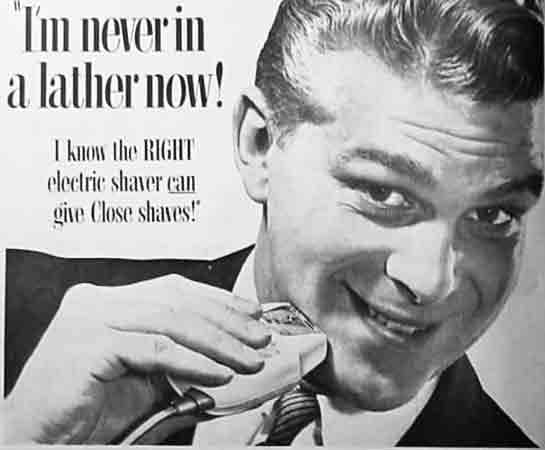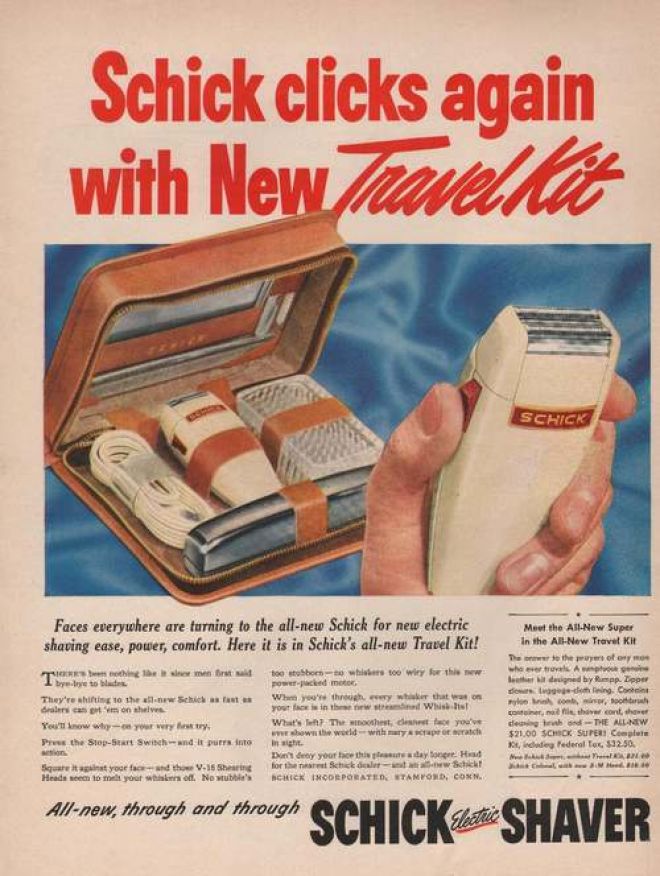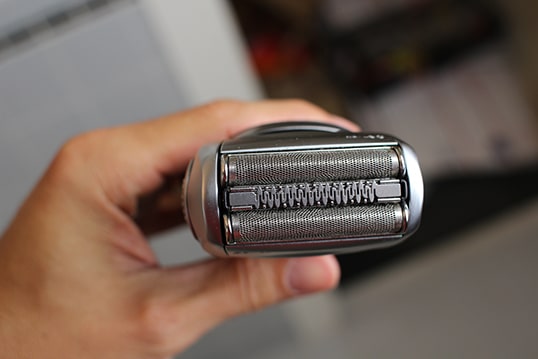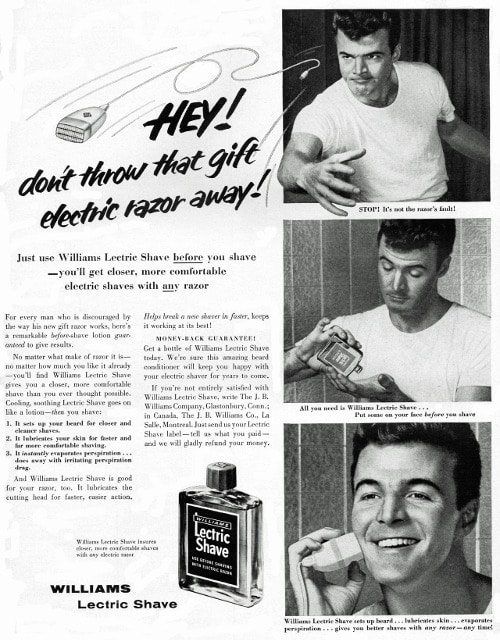
The Art of Manliness has introduced thousands of men to the joys and pleasures of traditional wet shaving with a safety razor or straight razor. I get emails and letters every month from readers thanking me for turning them on to the idea of shaving like their grandpas did. It’s simply a cheaper, better shave than you can get with one of those fancy multi-bladed razors and especially electric razors….right?
The last time I had shaved with an electric razor was when I was 16 years old. That was almost 15 years ago. I remember the shave from my electric razor being poor and extremely uncomfortable. Shaving with it was akin to holding a small rodent to my face and letting it chew off my stubble. Terrible razor burn (particularly on my neck) was the typical result.
But last year, after shaving with a safety razor for nearly a decade, I started wondering if electric razors had gotten any better. We’ve had a lot of technological innovations since I walked the halls of Edmond North High School. I figured if we’ve been able to create smartphones that are more powerful and robust than my family’s 1998 desktop computer, surely electric shaving technology had also improved.

And I’ll admit that I also wanted to revisit the electric razor out of pure laziness. Since becoming a dad twice over, I’ve had many a morning when I didn’t have much time for a wet shave and wished I could quickly remove my whiskers without slicing up my face. One of the big selling points of electric shaving is the convenience factor: you save time and effort by eliminating the need for water and shaving lather. Just turn the thing on and start shaving — anytime, anywhere. The idea certainly sounds pretty nifty.
So I set out on a year-long experiment to see if modern electric razor tech could get me to put away my safety razor and turn me into a convert.
What were the results? Read on.
A Brief History of Electric Razors

Before we get to my reviews, I thought it would be interesting and helpful to offer a bit of history on electric razors and detail the differences between the two main types.
The predecessor of the electric razor was a wind-up safety razor that vibrated the blade back and forth (sort of like those battery-powered Gillette Power Fusion razors do today). It was invented back in 1906 by W.G. Shockey and was actually pretty popular during the first quarter of the 20th century. You still had to use shaving cream, but the idea of mechanized shaving had been born.
It wouldn’t be until 1927 that Jacob Schick invented the first fully electric, dry-shaving razor. Schick says he got the idea for the device while serving as a lieutenant colonel in the U.S. Army. According to Schick, when he was stationed at an outpost with extremely cold weather, he injured his ankle, which forced him to crawl out of bed every morning to chip away and melt ice for the water he needed to shave. Believing there had to be a better way, Schick set out to invent an electric razor that could provide a completely dry shave. His finished product contained oscillating blades — sort of like barber clippers — and needed to be plugged into a power source. Schick’s electric razor caught on, especially with travelers, and soon most trains, planes, and ships had electric sockets in the bathrooms into which a man’s shaver could be plugged.

How’s that for convenience?
In 1937 Remington introduced their Close Shaver and added a microscreen foil over the oscillating blades for a more comfortable shave. Like the Schick electric razor, you needed to be tethered to a power cord to use it. Remington would establish itself as the leader in foil razors, and they created a devoted following. Former New England Patriot’s owner Victor Kiam loved his Remington shaver so much that he bought the company. In fact, “I liked the shaver so much, I bought the company,” became Kiam’s catchphrase in Remington commercials and made him a household name in the 1980s.

In 1939 the Philips company began marketing an electric razor with two heads and a rotary blade. Instead of oscillating blades to cut the whiskers, the Philips circular rotary blade spins to trim your stubble. The marketed benefit of the rotary razor over the foil razor is that the former’s size and shape does a better job of reaching those hard-to-shave parts of your face like the neck and jawline. In 1966, Philips introduced the triple head rotary razor — a model that continues to be the standard among rotary razors today. Philips bought Schick’s patents and trademarks in 1981, thus strengthening their position in the electric razor market. The company continues to be a leader in electric razors — particularly the rotary variety.
By the late 1940s, battery-powered electric razors entered the market, and in 1960, Remington introduced the first rechargeable battery-powered electric razor.

The companies producing electric razors marketed them as tools and accessories for the jet-set, affluent man. From the 1930s and well into the 1980s, electric razors were often packaged in silk-lined or leather clamshell cases to imbue the razor with the aura of luxury.
Since the rise of the electric razor during the post-War years, the various electric razor companies have been in an arms race to add features and design elements to their razors to make them more appealing to men.
And that brings us to my review of the two leaders in the modern market.
The Results of My Year-Long Experiment With Electric Shaving

Bob’s smile would vanish a few moments later, when he realized he was in fact holding a small, stubble-chewing rodent to his face.
For my experiment I bought Consumer Reports’ top-rated foil shaver (the Braun Series 7) and its top-rated rotary shaver (Philips Norelco SensoTouch 3D).
These suckers were expensive, but I wanted to go top-of-the-line to make sure I was testing out the latest and greatest in electric shaving technology. Let’s see how they did.
Braun Series 7 Foil Shaver

The Braun Series 7 sitting in its charging/self-cleaning stand.
For the first six months of the experiment I used a Braun Series 7 Foil Shaver. My first electric razor was a foil style, so it was familiar to me. When I purchased the Series 7 back in January 2013, it cost me $250. Jeezum! It’s now $195 on Amazon.com. Still pricey.
So what did I get for $250?
Well, Braun has incorporated what they call “intelligent sonic technology” into this shaver, which, while it isn’t smart enough to help you with your calculus homework, does allow the head to vibrate at 10,000 micro vibrations per minute. This is supposed to help capture more hair. Also, the head is outfitted with “ActiveLift Technology” which is supposed to lift up those flat lying hairs on your face and neck so the razors can cut it.
Other features include three personalization modes that allow you to control how soft or aggressive the shave is, a tilting head that adjusts to the contours of your face, a trimmer, and a self-cleaning system that cleans, charges, lubricates, and dries your razor.
Sounds like a lot of whiz-bang coolness. But how did it shave?

The head of the Braun Series 7. Notice the foil cover.
I could consistently get a close and smooth shave on my cheeks with the Series 7; the results anywhere else were sub-par. The place that caused me the most frustration was on my neck; no matter how thorough a job I did, patches of unshaved whiskers would remain. And because I kept passing the razor over my neck again and again so I could get those stubborn hairs, I just ended up with unshaved whisker patches and really irritated skin — the same problem I had with my 1998 electric razor. I’d always have to go back with a wet safety razor to clean up the whiskers the Series 7 left behind.
The instructions said it could take a few weeks for my skin and beard to “adjust†to shaving with a foil electric razor, so I hoped things would get better with time. They never did.
One thing I quickly learned when shaving with an electric razor is that you can’t let your beard get too long before shaving. When you have long whiskers, the razor yanks on your beard and then cuts, resulting in an extremely uncomfortable shave. Also, the patchiness increases the longer you wait. If you’re going to go with an electric razor, you’ll need to make sure to shave every day.
The self-cleaning system on the Series 7 was pretty nifty. It was nice knowing that my razor was sanitized and lubricated before each shave.
But besides this feature, there’s not much to write home about. The razor pretty much performed exactly the same as the $40 version I had in high school a decade and a half ago.
Philips Norelco SensoTouch 3D

The Phillips Norelco SensoTouch 3D in its charging/self-cleaning stand.
During the second six months of my year-long experiment, I used the Philips Norelco SensoTouch 3D electric razor. It’s a rotary razor; something I’ve never used before. This was the Consumer Reports top-rated rotary razor in 2012. When I purchased it back in January 2013, it cost — are you sitting down? — $350. Yowzer.
With a price like that, I was expecting it to leave my face and neck smoother than a baby’s behind while gently massaging it with a little robotic hands. So what did I get for $350?
The head on the SensoTouch 3D has a “Gyroflex 3D Contour System.” Translation: the head is divided into three parts that move independently, allowing the razor head to flex outward and tilt inward so as to follow the natural contours of your face. Each of those independently moving parts on the head have a rotary razor with “UltraTrack” shaving technology, which includes three specialized shaving tracks: slots for the long hairs, channels for the medium-length hairs, and holes for the shortest stubble. Added to the “UltraTrack” technology is Philips Norelco’s patented Super Lift&Cut dual blade system that lifts hairs and cuts them comfortably beneath the surface of your skin.
Like the Braun Series 7, the SensoTouch 3D comes with a built-in trimmer as well as a charging stand that seconds as a self-cleaning system.
One stand-out feature of the SensoTouch 3D is that you can do wet shaves with it too — even in the shower. Just apply your favorite shave cream or gel, Braun says, for a more comfortable, smoother shave.
So how did it perform?

The rotary head on the SensoTouch 3D. Each part pivots and moves to adjust to the contours of your face.
According to the instruction manual that came with the SensoTouch, if I had been using a foil razor for my shaves I needed to give my beard six weeks to adjust to the rotary razor. Like I mentioned above, the foil razor features blades that shift back and forth, while the rotary razor blades whirl around. I guess you have to train your whiskers to get used to that whirling cut action. So to be fair, I waited six weeks before I started comparing the shave between the Series 7 and the SensoTouch.
Shaving with a rotary razor has a bit of a learning curve if all you’ve used are foil razors. Instead of making straight up and down strokes like you do with a foil razor, with a rotary razor like the SensoTouch, you need to make small, circular clock-wise motions. That was surprisingly trickier than I thought it would be.
Overall the SensoTouch provided a superior shave than the Braun Series 7. It gave me a close, smooth shave on the cheeks and other flat areas like the Series 7 did, but where the SensoTouch really outperformed the Series 7 foil razor was on the neck and hard-to-shave jawline areas. The smaller, contouring rotary heads on the SensoTouch left fewer whisker patches on my neck than the Series 7 did. This isn’t to say the SensoTouch got all those hard-to-cut whiskers in one fell swoop, though; I often had to do several circular passes to get the job done and even then a stray whisker or two would be left behind. If I was shaving dry and was particularly aggressive with the razor, I still had some bad skin irritation.
I could reduce this irritation if I used the SensoTouch in a wet shave, but I don’t feel like it provided a closer shave. Plus, I felt that shaving wet with an electric razor sort of defeated one of the primary benefits of an electric razor — the convenience of not having to do a wet shave. So I didn’t shave wet with it very often.
While the SensoTouch performed better than the Series 7, I can’t give it a glowing endorsement. Saying it gave a better shave than the Series 7 is like saying it’s better to try to stab a Grizzly bear with a butter knife than a spoon. I still had whiskers left on my neck and jawline after shaving with the SensoTouch, which would necessitate me going back over the area with a safety razor to clean things up. And while I had less irritation with the SensoTouch than the Series 7, some irritation remained.
Bottom line: the SensoTouch gives a decent shave in comparison to the Series 7, but I don’t think it was worth the $350 I paid for it.
Does Lectric Shave Help?

I know how you feel, buddy. Would Lectric Shave redeem my electric razor experiment?
A few months into my electric shaving experiment I was disappointed with the amount of stray whiskers the razors were leaving behind. I was getting tired of having to rub the razor head over my sensitive neck skin again and again, only to have to ultimately bust out my safety razor to clean things up.
But then, one night while I was watching Pawn Stars, a woman re-entered my life who I hadn’t seen in a long time.
It was Carmen Electra.
Like many dopey American teenagers from the 90s, I sometimes watched MTV’s Singled Out after school. Playboy Playmate of the Year Carmen Electra was the buxom female co-host on the show in 1998 — the same year I got my first electric razor.
I hadn’t seen much of Ms. Electra since my high school days, and then there she was, sultrily pitching a men’s grooming product called Lectric Shave. I’d seen this stuff before, but never paid much attention to it since I didn’t use an electric razor. I can only imagine the pitch meeting for this Lectric Shave campaign. “Guys! I got the greatest idea! It’s called Lectric Shave, right? How’s about we get Carmen E-lectra to pitch it. Get it? Lectric? Electra? We’ll make millions for the client! Millions!”
I learned from Carmen Electra in the Lectric Shave commercial that the reason I was getting poor shaves with my electric razor was because my “beard was laying down.” If I were to splash a bit of Lectric Shave on my skin before shaving with my electric razor, my whiskers would pop up to attention like a boot camp soldier, allowing me to get a “52% closer shave” than I would without it. And then Carmen Electra would appear out of nowhere and sensually run her hands across my face and chest.
So the following day I went to Walgreens and bought some Lectric Shave.
At my next shave, I cracked open the bottle and was pleasantly surprised by the nice, masculine scent. I splashed some on. Your beard needs to be dry when you do this and then you need to wait a minute or two to let the Lectric Shave dry before you start shaving. I guess I was expecting to feel my whiskers actually start standing up straight, but I really didn’t feel much of anything. I suppose my skin felt a bit tighter, much like the feeling you get when applying rubbing alcohol to your skin (and indeed alcohol is the product’s first ingredient).
After waiting a minute, I started to shave. The results?
No noticeable difference with the Braun Series 7. Still not very comfortable, and I still had those stray neck whiskers left behind. And on top of it all, Carmen Electra didn’t appear in my bathroom to fondle my face. Damnit! What a waste of $2.5o. I could have bought a Pepsi Max with that.
I repeated the Lectric Shave experiment with the SensoTouch 3D, and again, no noticeable difference in shave closeness or patch reduction.
So, no, Lectric Shave doesn’t seem to help you get a closer electric razor shave. It does smell nice, though.
Concluding Thoughts
Electric shaving is an idea that sounds great in the abstract, but unfortunately falls quite short in practice.
Even today’s high tech electric razors still feel like a small rodent is chewing on your face. Because I had to go over my neck again and again with the razor to try to get those stray whiskers, I got the same ingrown hairs and razor burn that I did from my 1998 electric razor, but this time I spent $250-$350 to get that crappy shave. Plus, when I added in the time it took to bust out my safety razor and a bit of shaving cream to clean up those stubborn hairs, shaving with an electric razor often took about the same amount of time as traditional wet shaving. Poof! There goes one of the industry’s biggest selling points.
The only thing that has changed in the electric razor market is the addition of bells and whistles like the self-cleaning stands and “micro-vibrations.” Which I guess is nice, but definitely not worth the sticker prices on these things.
After a year of shaving with electric razors I can wholeheartedly recommend that you DON’T shave with them. They’re handy for travel or a day when you’re feeling lazy, and you don’t care about getting a great shave. But you’ll get a better, closer, more comfortable shave with a safety razor or even a straight razor. And I’m not just saying that because of my penchant for all things grandpa. I “scientifically†tested it!
For those of you who are unconvinced, and still want to shave with an electric razor, the lesser of two evils would be the Phillips Norelco SensoTouch rotary razor. I got a more consistent, closer shave with less irritation than with the foil razor. I’m pretty sure you could get a cheaper rotary razor and still get about the same quality of shave as you could with the SensoTouch. (Jeremy occasionally uses the substantially more affordable Philips Norelco model, and says it provides a decent shave, with none of the bells and whistles. Although he also notes that it still feels like a stubble-chomping squirrel, especially on the neck.)
Next Experiment: Is Shaving with a Multi-Blade Cartridge Razor as Horrible as I Remember?


